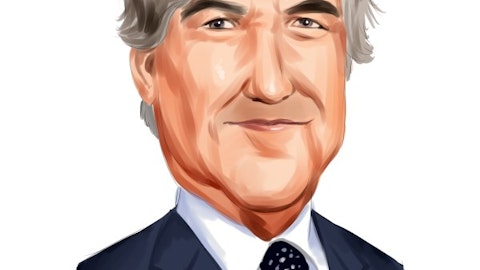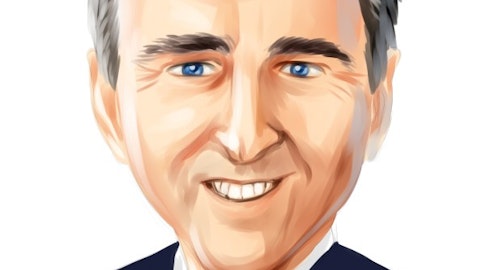Arco Platform Limited (NASDAQ:ARCE) Q4 2022 Earnings Call Transcript March 30, 2023
Operator: Good afternoon, everyone, and thank you for standing by, and welcome to Arco Platform’s Fourth Quarter and Full Year 2022 Earnings Call. This event is being recorded and all participants will be in a listen-only mode during the company’s presentation. After Arco remarks, there will be a question-and-answer session. At that time, further instructions will be given. This event is also being broadcast live via webcast and may be accessed through Arco’s website at investor.arcoplatform.com where the presentation is also available. Now, I’ll turn the conference over to Carina Carreira, Arco’s IR Director. Carina, you may begin your presentation.
Carina Carreira: Thank you. I’m pleased to welcome you to Arco’s fourth quarter and full year 2022 conference call. With me on the call today, we have Arco’s CEO, Ari de Sa Cavalcante Neto; and Arco’s CFO, Roberto Otero. During today’s presentation, our executives will make forward-looking statements. Forward-looking statements generally relate to future events or future financial or operating performance and involve known and unknown risks, uncertainties, and other factors that may cause our actual results to differ materially from those contemplated by these forward-looking statements. Forward-looking statements in this presentation include, but are not limited to statements related to our business and financial performance, our expectations and guidance for future periods, our expectations regarding strategic product initiatives and their related benefits, and our expectations regarding the market.
These risks include those set forth in the documents that we issued earlier today as well as those more fully described in our filings with the Securities and Exchange Commission. The forward-looking statements in this presentation are based on the information available to us as of the date hereof. You should not rely on them as predictions of future events and we disclaim any obligation to update any forward-looking statements except as required by law. In addition management may reference non-IFRS financial measures in this call. The non-IFRS financial measures are not intended to be considered in isolation or as a substitute for results prepared in accordance with IFRS. We have provided a reconciliation of these non-IFRS financial measures to the most directly comparable IFRS financial measure in our press release.
Please note that except from revenue, gross margin, selling expense, G&A, and cash flow from operations all other financial measures we discuss here are non-IFRS. And growth rates are compared to the prior year comparable period unless otherwise stated. We also note that year-over-year comparisons are affected by acquisitions that were not included in our 2021 financials. Let me now turn the call over to Ari, Arco’s CEO.
Ari de Sa Cavalcante Neto: Thank you, Carina, and thanks, everyone for joining today’s conference call. 2022 was an important year for Arco. We delivered solid results across our main commitments with investors, including another strong year for ACV growth. The resumption of our healthy operating cash flow profile and important evolutions in our integration agenda to better and more efficiently serve our clients and continue to grow in a more sustainable way. On cash generation, we showed improvements on all metrics that drives free cash flow generation, including higher profitability with 150 basis point expansion of our adjusted EBITDA margin to 36.5%, better capital allocation, taking our CapEx back to historical levels at 9% of revenues, lower working capital consumption, and finally, a lower effective tax rate.
As a consequence, we generate the higher cash flow after CapEx of Arco’s history. On growth, the commercial cycle for 2023 year prove that we can focus on cash flow generation and dedicate energy to agendas without jeopardizing our growth rates. We posted intake and a strong price increase across all brands leading to a 24% year-over-year ACV growth to R$1.9 billion, 100% organic. Our two main Core brands combined and sustained high growth rates at 96% in our most recent acquired brand COC delivered good results in terms of growth, retention, and price increase. Our cross-selling efforts were once again key to such successful commercial cycle for Supplemental solutions with 71% of its intake originated from cross-sell. Finally, we had an important outcome from our integration agenda with the corporate organization leading to improved process and higher G&A dilution.
We remain focused on reducing redundance in IT and in ArcoTech platform aiming at a more efficient capital allocation and higher quality across the brands. I will now turn the call to Otero who will continue the presentation. Otero, please go ahead.
Roberto Otero: Thank you, Ari. Good evening, everyone. Thank you for your time. Moving to Slide 5, net revenues for the fourth quarter of 2022 were R$679 millions, a 47% increase year-over-year and representing a 34.7% revenue recognition of the 2023 ACV, which will detail a few slides ahead. Net revenues for 2022 totaled R$1,775 million, a 44% increase versus 2021 or 37% organic growth when excluding M&A is concluded in 2021 and 2022. Despite a 62% increase in costs year-over-year, mainly due to pressures coming from paper prices, we managed to deliver on 150 basis points EBITDA margin expansion year-over-year in 2022 due to the 4% contraction in our G&A and a more efficient sales process. Moving to Slide 6, as mentioned by Ari, 2022 marks an inflection point on our cash flow trajectory.
We revisited processes made structural improvements in our operations and focused on better allocating our capital. As a result, we improved in every line of our operating cash flow leading to a free cash flow to firm of R$122 million at R$267 million expansion when compared to last year. We improved our working capital dynamics with delinquency days receivables, and collection returned to pre-pandemic levels. Our effective tax rate was 13% in 2022 versus 18% in 2021 as we optimized our corporate structure to take advantage of the tax benefits on recent acquisitions. And finally, our CapEx went back to historical levels at 9% of revenues below the guidance provided to the market of between 10% and 12%. On Slide 7, we showed the evolution of our CapEx in recent years.
2020 and 2021 were years of heavier investments, not to mention is slightly lower revenue recognition due to the students dropouts in our partner schools. As we integrated and improved acquired businesses while invested in tools to support our partner schools to weather the back to pandemic. In 2022, we invested in a more efficient and integrated way. Adjusted EBITDA minus CapEx also returning to historical levels, and we believe there is room to further improve in years to come. Moving to Slide 8, we ended a year with R$1,305 million in loans and financing and R$1,391 million in accounts payable to selling shareholders, translating in a 3.1 time net debt to adjusted EBITDA multiple down 60 bps from end of 2021. We’re confident our cash position combined with future cash generation from the operations is enough to cover for our short-term obligations, and we are committed to continue reducing our leverage through higher profitability and strong cash generation years to come.

Copyright: wavebreakmediamicro / 123RF Stock Photo
To conclude this session on Slide 9, we present the main highlights of our 2022 ESG report. We had an important improvement in key metrics and are confident in the achievement of our 2025 goals. We increased our impact on education with the expansion of students impacted by our pedagogical solutions and initiatives from the Arco Institute and approval rates universities through SISU of students using our solutions increased 33% in 2022. We increased the percentage of women in leadership positions and the percentage of ethnical diversity. Our voluntary turnover reduced almost 5 percentage points, and our employee NPS improved 6 points versus 2021. Finally, we concluded our first Carbon Footprint measurement for scopes one and two, and in 2023, we’re committed to analyze the best alternatives to reduce or compensate for such emissions.
We know we have an important and critical role in our society and we are committed to continuing impact lives through quality education and a sustainable business. Moving to Slide 11, we are proud of the results of our 2023 commercial cycle. Our ACV book is reached R$1,930 million, representing a strong 24% year-over-year organic growth. The Core segment grew by 23% year-over-year, R$1.5 billion and over almost 1.8 million students. Our Supplemental Content Solutions grew by 35%, of R$393 million and over 876,000 students. We’d like to highlight the stellar performance of COC, a brand we acquired end of 2021 and had its first commercial cycle under Arco’s umbrella in 2022. The solution delivered 30% year-over-year growth, a 15 percentage point improvement in retention to 95%, and our price increase 5 percentage points above inflation.
Escola da Inteligência and Pleno, our social-emotional products delivered more than 40% growth year-over-year, confirming social-emotional as a relevant competency inside school. And on cross-sell, 71% of the new school intake for Supplemental Content Solutions was originated from cross-sell initiatives. Despite increasing the number of Core students using one or more Supplemental Content Solutions to 18% from 15% in 2022 school year, there is still room to increase this penetration and are convinced of the benefits of this strategy to the entire portfolio. According to our analysis, referrals increased by 23 times the lead conversion of Supplemental Content Solutions and having a supplemental solution reduce Core churn by 50% for those schools.
On Slide 12, we detailed the buildup of our 2023 ACV bookings. Our growth has always relied on our ability to retrain our clients, improve our value proposition, driving price increases, excel our solutions within our partner schools and attract new partner schools. This year, it was not different. Despite the slightly higher consolidated churn at 91%. Our main Core solution sustained retention rates above 95%. This year’s average price increase was more than 3 percentage points above inflation at 9%, and we delivered the largest ACV of new contracts in the company’s history at R$391 million. Moving to Slide 14, we’d like to provide a quick update on Isaac’s operation. Isaac concluded 2022 with the top line is slightly higher than expected at R$163 millions, almost 1,200 partner schools and an annual recurring revenue of R$235 million.
On Slide 15, we list Isaac’s main priorities for 2023, which include investments in the go-to-market to fully consolidate its leadership position in the market, enhanced product offerings and unlocked scale gains, and improve efficiency and capture synergies with our call through cross-sell leading to our reduction in its CAC. I’ll now turn the call back to Ari. Ari, please go ahead.
Ari de Sa Cavalcante Neto: Thank you, Otero. On Slide 17, we present our four main priorities for 2023. First, on Slide 18, we’ll continue improving our structure to better and more efficiently serve our clients. We have initiated our efficiency roadmap in 2022 with the corporate reorganization and integration of the supply chain teams under a single structure. In 2023, we’ll focus on strategic sourcing, especially on initiatives related to printing costs, logistics and inventory discards and optimizing our internal IT systems and improving the quality of our educational platforms. On enhancing our sales efficiency with the creation of an operational excellence center aiming to increase sales performance, elevate our planning and monitoring capacity, support optimal capital allocation between business units and lead cross brand initiatives.
On Slide 19, our second priority is to sustain our high growth profile. We’ll continue to use our proprietary sales process, the quality of our solution in our reputation to increase our market share and the penetration of solutions in current partner schools. After years of strong growth and creation of this large platform, cross-sell became a central piece in our growth. So we’ll continue to leverage on the close relationship with our partner schools to expand the adoption of other Arco solutions. Finally, as we continue to invest in updating and evolving our solutions, we are able to support price increases above inflation while improving satisfaction levels. On Slide 20, our third priority for 2023 is boost cash flow generation. We are confident that by making our operation leaner and more efficient our cash flow profile, we will improve significantly in upcoming years.
We’ll do so by improving our process and structure, optimizing our corporate structure, and continue to reduce our effective tax rate. Of course, also investing our capital on a more diligent and efficient manner. Thank you for your time. Operator, we can now open for questions.
See also 11 Best American Oil Stocks To Buy and 15 Mormon Owned Companies and Stocks.
Q&A Session
Follow Arco Platform Ltd. (NASDAQ:ARCE)
Follow Arco Platform Ltd. (NASDAQ:ARCE)
Receive real-time insider trading and news alerts
Operator: Thank you. The floor is now open for questions. The first question comes with Lucca Marquezini with Itau BBA. Please go ahead.
Lucca Marquezini: Good evening, everyone. Thank you for taking our question. So in the fourth, wherewe saw a significant dilution in G&A expenses, so if could youplease provide a call on the initiatives that latch this dilution. And also if you can comment if this initiatives have provide matured or appreciate expect more dilution going forward and would be helpful, please. Thank you.
Roberto Otero: That previously were not centralized or fully integrated across the brands, okay, that we own. So we’ve been integrating whatever we think that is not what drives differentiation of our brands and more we think we can better serve our clients by centralizing and integrating, okay. This also applies to back office. We still had some back office areas that were located at the brand level that we’ve been integrating into the holding level. As a consequence, we managed to decrease the size of some teams along 2022. The second reason relies on, I mean, managing third party services and third party suppliers in a more efficient way and internalizing some activities that previously we were hiring from third party suppliers in general, okay.
So the largest effect was in 2022, when we look from 2023 onwards, I think this will allow us to grow the G&A at a much slower pace when compared to top line growth, okay. So we should not expect G&A to reduce in nominal terms, I think what we’ll €“ in absolute terms, sorry, what we’ll see is G&A dilution contributing to margins, okay. So that’s the expectation.
Lucca Marquezini: That’s very clear. Thank you, Roberto.
Roberto Otero: Thank you, Lucca.
Operator: The second question comes with Marcelo Santos with JP Morgan. Please go ahead.
Marcelo Santos: Hi, good evening, Ari, Otero, Carina. Thanks for taking my question. I have two actually. The first one is you provided information on how the ACV changed on price, 9% on price, 9% on churn. How does this defer between Core and Supplemental Solutions? Could you give us some idea on how this changed between two types of solutions? And the second question, there was a decline in the ACV of other Supplemental Solutions. I know it’s quite small. I just wanted to understand better you mentioned you stopped some of the sales efforts for some of these initiatives. So what are you changing on those initiatives, which are these initiatives that are responsible for this decline? Thank you.
Roberto Otero: Hi, Marcelo, Otero here. Thank you so much for the questions. On the first one, I would say starting with pricing, this €“ in this cycle, we saw a more similar pricing performance when comparing Core to Supplemental, which is a change when we compare to historically Supplemental or the level of pricing power we had for Core, we did not have for Supplemental historically this cycle, we managed to increase both Core and Supplemental products by a similar rate, okay. So this is to answer your point on pricing. When it comes to retention, I would say that for Core brands, for most of the Core brands we saw isstability or improvement, okay, in retention taking for example, SAS,S-A-S as an example we reach at 98.5% retention rate.
This is the most premium brand we own, as you know. So in general, it was a very good performance in Supplemental, as you know, I mean, retention rates for Supplemental are still lower when compared to Core, okay. So that’s why when you look at the combined churn, it shows a deterioration compared to last year, mostly because of the higher share of Supplemental in the base of ACV, okay. So this is the first aspect there. And the second one, in this cycle, we saw Conquista, which is a lower price point Core also gaining share in the overall ACV and Conquista is still has slightly lower retention rate when compared to other Core brands. So it was mostly a mix effect, okay, driving this 9% churn, which shows to be higher than last year. But when you look on the brands and compared to last year in most of them, we saw stability.





